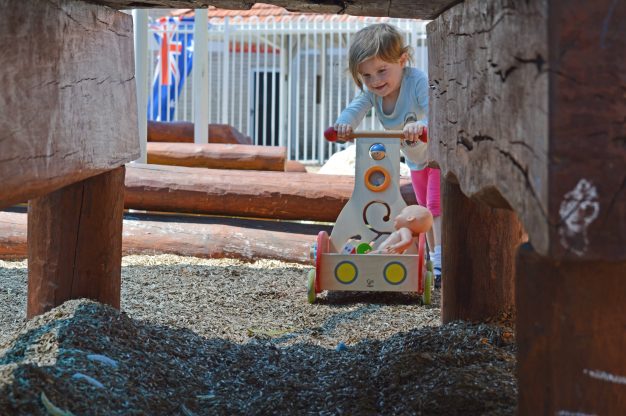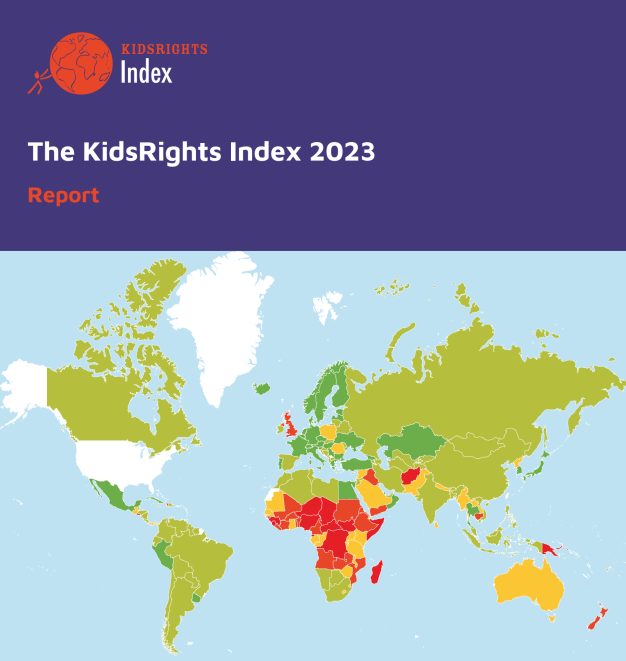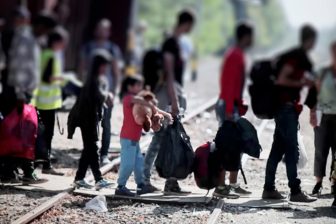
KidsRights Index 2023: ‘Immediate action’ needed to preserve children’s rights
Increased food and energy costs plus Russia’s war in Ukraine mean that a quarter of the world’s children will be living in poverty this year.
They are also at risk from climate change and the ongoing effects on their physical and mental health from the COVID pandemic, according to the KidsRights Index, the only ranking that reviews annually the state of children’s rights globally.
Compiled using figures provided by the various agencies of the United Nations, the KidsRights Index describes what it calls ‘a polycrisis of unprecedented levels’ currently being experienced by children as they continue to suffer on multiple levels.
It says the war in Ukraine has disrupted global supply chain security, which in turn has fuelled a huge rise in food and energy prices and created a steep cost-of-living crisis. This has significantly impacted on children and their caretakers who are already struggling from the after-effects of the pandemic.
‘Policycrisis of unprecedented levels’
One in four children across the world are projected to be living below the poverty line this year, as a result of these developments. The KidsRights Index Report 2023 shows that, most likely as a result of rising poverty, under-5 mortality rates in countries such as Madagascar and Niger have risen. Likewise, the rates of child labour are reported as having doubled or even tripled in some countries, including Belarus, Colombia and Venezuela.
The KidsRight Index is based in The Netherlands, and is an initiative of the KidsRights Foundation, in partnership with Erasmus University Rotterdam and the International Institute of Social Studies. It ranks to what degree countries are meeting the UN Convention on the Rights of the Child and, crucially, how equipped they are to improve children’s rights
It says that Ukraine’s 7.5 million children are the most disproportionately affected by the war and large numbers were displaced from their country of origin.
The report also shows the devastating impact of climate change on children’s rights in its first experimental analysis of this matter on this area. Youngsters living in Bangladesh, China, Egypt, Indonesia, India, Mexico, Pakistan, the Philippines, Republic of Korea, Thailand, and Vietnam face particularly high exposure to climate hazards, shocks and stresses.
It also highlights the destructive effects of environmental disasters such as the flash floods that hit Pakistan in 2022 and washed away 27,000 schools. Two catastrophic earthquakes hit Turkey and Syria earlier this year, with 3.7 million children affected in Syria alone.
Children have also been hit by disruptions to immunisation programmes due to COVID, with child vaccination rates set back by more than a decade as a result of 67 million children missing out entirely or partially on routine immunisations between 2019 and 2021.
All of these events have contributed to the loss of lives, denial of basic rights, unfulfilled needs, a limiting of potential, and an increase in poverty levels, which are affecting children in every country across the world and will continue to do so for generations.
Marc Dullaert, Founder and Chair at KidsRights, says governments need to focus their efforts on investing in children for the betterment of our society and the planet: “This year’s report is most alarming. Our promising next generation is being disadvantaged at every turn in this post-pandemic state of polycrisis – whether it is about the devastating wars in Ukraine and Sudan, the crippling cost-of-living, tragic environmental disasters, the banning of girls from access to higher education in Afghanistan, or the all-time-low immunisation rates globally. Immediate actions are required on the part of states, humanitarian and other relevant agencies to protect children from this current catastrophe and to pave the way for a more positive and hopeful future.”

The past year of data collection and analysis results in a complex and gloomy picture of children’s rights across the world. While there was some jostling for the top position in the Index, with Sweden jumping to number one and thereby taking the place of Iceland which had held this position for the past four consecutive years, the overall record showed deterioration rather than progress.
All countries were ranks using five ‘Index Domains’: Life, Health, Education, Protection and the Enabling Environment for Child Rights. Most countries showed poorer results this year than last year, with only four managing to improve their overall ranking – Greece, Kuwait, Ukraine (based on its pre-war situation) and Uzbekistan. The total picture reveals that children’s rights around the world are in an ‘alarming state’ and this, says KidsRights Index, requires ‘immediate and forthright action’.
‘A complex and gloomy picture’
What’s more, when individually assessing countries against Domains 1 to 4, not one of the 193 countries was awarded a high score – with all either receiving ‘medium’ or ‘low’.
If a tentative new domain were to be added on the topic of climate change, the lowest scoring countries in that domain would be South Sudan, Afghanistan and Chad, while Iceland, Luxembourg and Finland would score best.
Russia’s war on Ukraine had a devastating immediate impact on the country, with Ukraine’s 7.5 million children paying the highest price of all. The UNHCR and UNICEF both predicted that at least 1.6 million of these children would likely be displaced outside their country of origin. The real figure is likely to be even higher.
The immediate impacts weren’t only physical, however, with it being estimated that 1.5 million Ukrainian children would need mental and psychological support to recover from their war experiences. This is especially problematic given the pressure the war has had on Ukraine’s healthcare system and now that access to trauma care is extremely limited due to a lack of medical supplies.
War and conflict
Ukraine is not the only country which has been deeply affected by fighting in the last year. Among other examples, heavy violence broke out again in Sudan in April 2023. Prior to the onset of war, Sudan had the highest child malnutrition rate in the world with over 8.5 million in dire need of humanitarian assistance. Just 10 days after the renewed violence began, one third of the healthcare facilities in Sudan were no longer functioning and the UN estimated that life-saving treatment was disrupted for around 50,000 children with Severe Acute Malnutrition (SAM).
An estimated one in four boys and one in three girls in Sudan have been unable to access education during the same period, and all children are now more vulnerable to abuse, displacement, and to recruitment from armed groups.
Over the past year, environmental disasters due to climate change have occurred with devastating impacts on infrastructure and society.
The Sindh and Baluchistan provinces of Pakistan were hit by flash floods in 2022 which caused irreparable damage to around 1.6 million children who were already suffering from malnutrition, and another 6 million who were suffering from stunting. The effect of the disaster on education prospects is also incalculable after an estimated 27,000 schools were washed away.
‘Relentless threat of climate change’
And the threat continues to loom, with children in eleven of the countries which changed clusters for worse due to the inclusion of Domain 6 (Climate Change) facing extremely high risk of being affected by climate and environmental hazards, shocks and stresses. This includes Bangladesh, China, Egypt, Indonesia, India, Mexico, Pakistan, the Philippines, Republic of Korea, Thailand, and Vietnam, in this year’s initial reports into the area.
Under the recent Taliban rule, Afghanistan reintroduced its total ban of girls from access to higher or secondary education in 2022. Education is a fundamental right of every child. Denying girls access to education raises real concerns not only around their educational prospects but also around their rights to holistic development, information, participation and general safety in all respects. There are also strong indications that this ban has already led to higher rates of child marriage and child labour in the country – reversing any positive progress that was made up to now.
‘Post-pandemic crunch on healthcare’
The pandemic interrupted childhood vaccinations almost everywhere, setting vaccination rates back to levels not seen since 2008. This is due to the negative impact of COVID-19 on the availability and accessibility of non-COVID vaccination services as well as on the perception of vaccines and vaccine readiness.
In fact, 67 million children missed out either entirely or partially on routine immunisation between 2019 and 2021, resulting in an exponential rise in zero-dose children. The percentage of zero-dose children is highest in the Democratic People’s Republic of Korea (DPRK) and Myanmar at a staggering 60%. Vaccinations for measles, polio and tuberculosis were not administered to any children in the Democratic People’s Republic of Korea in 2022, putting half a million (500,000) of North Korea’s children at risk of vaccine-preventable diseases.
KidsRights is an international non-governmental organisation that promotes the wellbeing of very vulnerable children across the world and advocates for the realisation of their rights. The KidsRights Index is produced in cooperation with Erasmus University Rotterdam (Erasmus School of Economics, and the International Institute of Social Studies). It sits alongside the Foundation’s prestigious and acknowledged International Children’s Peace Prize, endorsed by the Nobel Peace Laureates, whose recipients have included Malala Yousafzai.
Click here for the various versions of the KidsRights Index Report 2023 that can be downloaded.
All figures provided by KidsRights Index 2023




